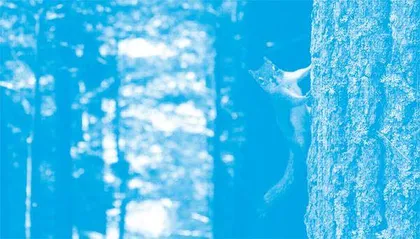In the Wrong Place at the Right Time: Invasive Species入侵物种:对的时间,错的地点
作者: 秦书未/译

Humans have moved species of plants and animals around, introducing them to new habitats, for as long as we’ve been on Earth. Early humans chased animals around or moved seeds when they ate fruits. Today, there are a variety of intentional ways that humans move other species around. For example, pets are imported, crops are transported, fish are stocked in ponds, livestock are moved to farms, and flowers are shipped. Many of these introduced species have been beneficial, such as European honey-bees that have proved to be excellent pollinators1 in the U.S. But, other introduced species have become invasive. Invasive species are those that escape from our control, spreading and causing harm to ecosystems.
自从人类生活在地球上以来,我们就一直在把动植物带往各处,将它们引入新的生活环境。早期人类到处追捕动物,也会因吃水果而带走种子。如今,人类有意地以多种多样的方式将其他物种带往各处,比如进口宠物、运输农作物、池塘养鱼、农场养牲畜、运送鲜花。很多引入物种是有益的,例如欧洲蜜蜂就在美国成为绝佳的传粉昆虫。然而,也有些引入物种成了“入侵物种”。入侵物种指的是摆脱了人类控制,蔓延生长并对生态系统造成危害的物种。
There are an unfortunate number of examples of species that humans have intentionally introduced, but later regretted introducing. Cane toads were brought to Australia in the 1930s to control populations of beetles that were harming the sugar cane crop. The toads thrived in their new habitat, not only eating the beetles, but eating other native insects, frogs, and bird eggs. Australia has since spent millions of dollars trying to control the cane toads that have spread all over the country. Eucalyptus trees were introduced to California as ornamentals. Their fast growth, flammability2, and toxic leaves have allowed them to outcompete native trees, spreading way beyond their intended boundaries. Both examples illustrate the challenge of accurately predicting outcomes when species are introduced to new habitats they have never occupied.
有的物种,人类特地将其引进之后却后悔了,这样的例子之多令人痛心。甘蔗蟾蜍在1930年代被引入澳大利亚,用于控制损害甘蔗收成的甲虫种群。结果,甘蔗蟾蜍在新的生活环境里旺盛地繁衍生息,不仅吃甲虫,还吃当地的其他昆虫、青蛙和鸟蛋。自那以后,澳大利亚花费了数百万澳元来控制蔓延全国的甘蔗蟾蜍。桉树作为观赏性植物被引进美国加州。它们生长迅速,易燃,叶子有毒,这些都使它们得以战胜本土树种。它们大肆扩张,分布范围远远超出预定边界。上述两个例子表明,若把物种引进其从未生活过的新环境,人们很难确切预测出后果。
Many unintentional introductions have also resulted in invasive species. Plant seeds that get stuck on clothing or vehicle tires may travel long distances from where they originated. Insects that get trapped in cars are released into new habitats. Unintentional introductions are not confined to travel on land. When ships fill their ballast tanks3, the seawater may contain living organisms. Zebra mussels from a ship’s ballast were introduced to the Great Lakes in the 1980s, and spread to other waterways throughout the U.S., becoming a menace as they clogged up pipes, reduced populations of native mussels, and damaged ship hulls. Millions of dollars have been spent trying to control these invasive mussels.
还有许多物种是无意之中引进的,却也成了入侵物种。黏附在衣服或汽车轮胎上的植物种子可以从原产地迁移到很远的地方,困陷在车里的昆虫到了新的生活环境才得以脱身。无意之中的引进并不局限于陆上传播。船舶抽海水灌满压载舱时,水中可能带有活体生物。斑马贻贝在1980年代由船舶的压载舱带入北美洲的五大湖,进而扩散至美国各地的其他航道。它们堵塞了管道,减少了本土贻贝的数量,损坏了船体,成为一大威胁。为控制入侵贻贝,美国已投入数百万美元。
What makes a species invasive?
成为入侵物种的原因
Many species that get introduced to new habitats do not survive because the conditions are not what they are adapted to survive in. The introduced species that do survive tend to have certain characteristics, such as the ability to reproduce quickly and outcompete species that are native to the habitat. Many introduced species have the advantage that a new habitat lacks the predators or parasites that have evolved to prey on it. For example, shortly after World War II, venomous brown tree snakes were accidentally introduced to the island of Guam, probably from ships. Encountering no natural predators, they spread rapidly and became voracious predators of native wildlife. Bird populations on Guam have still not recovered.
许多物种进入新的栖息地没能存活下来,因为它们无法适应新的环境条件。存活下来的引入物种往往具备某些特点,比如能快速繁殖并战胜本土物种。很多引入物种在新的生活环境中没有天敌,也就是没有进化出以它们为猎物的捕食性动物或寄生生物,这对它们而言是有利的。例如,二战结束后不久,有毒的棕树蛇或许是经由船只被意外带到关岛。因为没有天敌,它们迅速蔓延,凶残地捕食当地野生动植物。关岛上鸟类的数量至今还未恢复。
The impacts are not trivial
入侵物种的影响不容小觑
The immediate impacts of invasive species on humans range from annoying to catastrophic. Bullfrogs native to the eastern United States have invaded the west, reducing populations of native fishes and frogs. Allowing hunting of the invasive bullfrogs, and sales of frog legs in fine restaurants, has in some places softened their impact on the native ecosystems. Northern snakehead fish introduced to the Chesapeake Bay watershed have proved so destructive to native fishes and other wildlife that Maryland and Virginia have passed laws to keep them in check4. A fisherman who encounters a northern snakehead fish is required to kill it, because it is illegal to possess or release it. The rats that many people in the U.S. take for granted (black and Norway rats, introduced from Europe) inflict billions of dollars worth of damage to stored grain on farms in the U.S. every year.
入侵物种对人类产生的直接影响,小至造成困扰,大至带来灾难。原产于美国东部的牛蛙入侵西部,减少了当地鱼类和蛙类的数量。有些地方允许猎捕入侵的牛蛙,也允许高档餐馆售卖牛蛙腿,这些措施已经减轻了牛蛙对当地生态系统的影响。引入美国切萨皮克湾流域的北方蛇头鱼对当地的鱼类和其他野生动植物造成了巨大伤害,以致马里兰州和弗吉尼亚州都通过了管控北方蛇头鱼的法律。渔民如果碰到北方蛇头鱼,就必须将其杀死,因为留着或者放了都不合法。美国很多人司空见惯的老鼠(从欧洲引进的黑鼠和挪威鼠)每年给全美农场贮存的粮食造成的损失高达数十亿美元。
When you transfer an organism, you also can transfer its associates, including parasites and predators. Transfers of oysters and ornamental plants have spread diseases and animal pests to many parts of the world. Think before you move an animal or plant around!
带走一种生物时也会带走与之伴生的物种,包括寄生其上和以之为食的生物。转移牡蛎和观赏性植物已经使疾病和有害动物扩散到了世界上的许多地方。把动物或植物带往他处之前,务必三思!
(译者为“《英语世界》杯”翻译大赛获奖者)